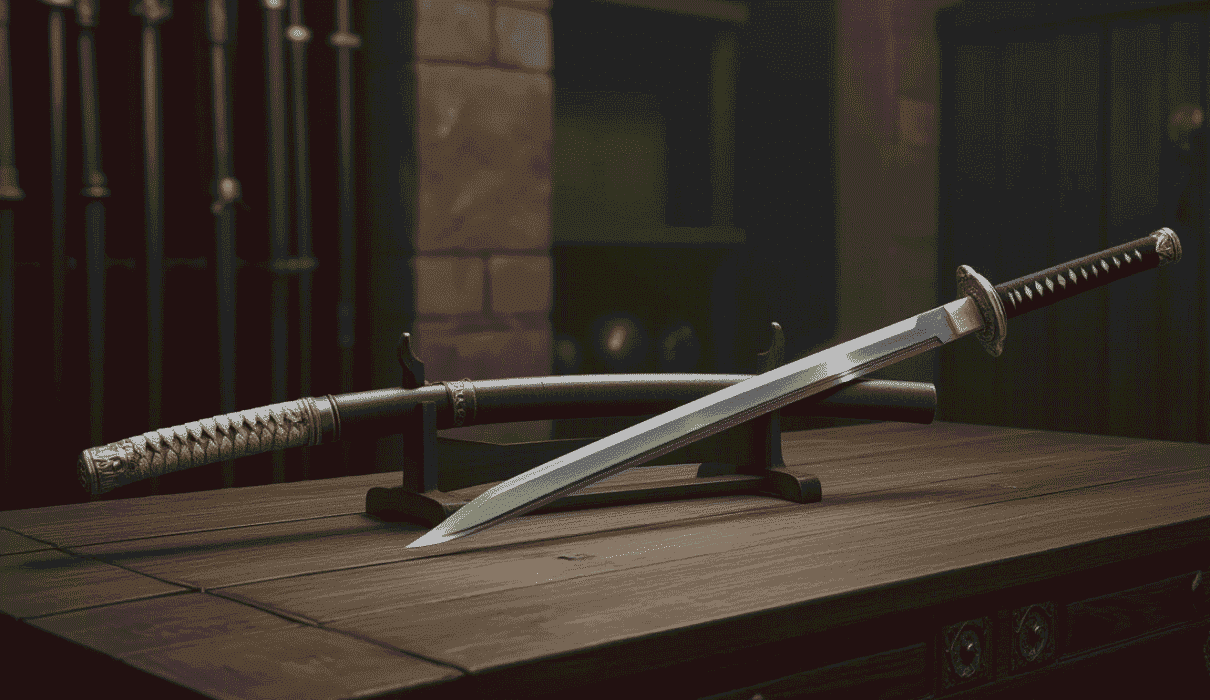Table of Contents
Introduction
If you’ve ever been captivated by the elegance of a katana or the might of a medieval longsword, you’ve probably considered buying one. But once you dive into the market, you’ll encounter two categories: real swords and replica swords.
They might look similar at first glance, but they’re worlds apart in terms of construction, purpose, and performance. Let’s explore the fascinating real vs. replica swords debate so you can choose the perfect blade—whether it’s for display, cosplay, training, or collection.
What Are Real Swords?
Real swords are functional weapons crafted with precision and strength. Often referred to as “battle-ready” swords, these blades are made using traditional forging techniques, designed to endure real-world usage.
Core Traits of Real Swords
- High-carbon or Damascus steel construction
- Sharpened edges suitable for cutting
- Full tang blade for balance and durability
- Tempered for strength and flexibility
- Often handmade by skilled blacksmiths
What Are Replica Swords?
Replica swords are primarily decorative. They mimic the appearance of famous or historical blades but lack the structure or materials needed for real combat or cutting use.
Key Traits of Replica Swords
- Usually made with stainless steel
- Dull edges and often lightweight
- Partial tang or decorative handle designs
- Focus on aesthetics over functionality
- Great for cosplay, display, or collectors on a budget
Real vs. Replica Swords: Key Differences
Comparison Table
| Feature | Real Swords | Replica Swords |
|---|---|---|
| Blade Material | High-carbon/Damascus steel | Stainless steel |
| Functionality | Fully functional | Decorative only |
| Tang Type | Full tang | Partial or hidden tang |
| Sharpness | Razor sharp | Usually blunt |
| Price Range | $200–$5,000+ | $30–$300 |
| Ideal Use | Martial arts, cutting, collection | Display, cosplay, gifting |
Why Choose a Real Sword?
A real sword is the top choice for:
- Martial arts practitioners (Iaido, Kendo, HEMA)
- Historical reenactments
- Functional collection pieces
- Serious sword enthusiasts
It offers:
- Authentic feel and cutting capability
- Greater historical and resale value
- Superior craftsmanship and materials
Why Choose a Replica Sword?
A replica sword is perfect for:
- Cosplay and costume events
- Decorative purposes at home or office
- Fantasy or anime enthusiasts
- Budget-conscious buyers
Advantages include:
- Affordability
- Lightweight design
- Safety for display or public use
Understanding Full Tang vs. Partial Tang
Full Tang (Real Swords)
- Blade runs through the entire handle
- Stronger and more balanced
Partial Tang (Replica Swords)
- Blade ends within the handle
- Weaker and prone to breakage under stress
Legality: Are Real or Replica Swords Legal to Own?
In most places:
- Replica swords are legal and often unrestricted.
- Real swords may face restrictions based on local laws—especially if sharpened or intended for self-defense.
Tip: Always check your local weapon regulations before buying or displaying a real sword.
Can Replica Swords Be Sharpened?
While technically possible, it’s not recommended:
- The blade may not be heat-treated
- Sharpening can create stress fractures
- It may void any manufacturer’s warranty
- Dangerous for untrained users
How to Tell If a Sword Is Real or Replica
Quick Identification Tips
- Check the tang: Real swords have visible full tangs.
- Test the weight: Real swords are heavier and better balanced.
- Look at materials: High-carbon steel = real; stainless steel = replica.
- Blade sharpness: Real swords have a functional edge.
Real vs. Replica Swords in Cosplay
For cosplay, replica swords are the safer choice. They’re:
- Lightweight and easier to carry
- Convention-safe (most events ban real weapons)
- Often modeled after popular movie/game designs
But if accuracy is a must, a dulled real sword might offer better authenticity—just be cautious with legality.
Are Antique Swords Real or Replica?
Antique swords can be either:
- Real: If they were originally forged for battle
- Replica: If they were made as collectibles or commemorative items
Always verify with experts or appraisers when investing in antique blades.
Training with Swords: What Should You Use?
If you’re practicing sword arts:
- Use a real sword (or a blunted training version like a bokken or waster)
- Avoid replicas—they can snap, chip, or cause injury
Display Purposes: Which One Works Best?
Replica swords are ideal for:
- Home or office decoration
- Wall mounts and sword plaques
- Gifts for fans of anime, games, or history
They require less care and pose fewer safety risks.
Maintenance: Real vs. Replica Swords
Real Sword Care
- Clean with mineral oil
- Store in a dry, moisture-free environment
- Sharpen when needed
- Use a protective sheath or stand
Replica Sword Care
- Wipe occasionally to prevent dust build-up
- Avoid high humidity
- No sharpening required
Where to Buy Real and Replica Swords
Real Swords
- Specialty swordsmiths
- Martial arts suppliers
- Reputable online stores
Replica Swords
- Comic conventions
- Fantasy merchandise retailers
- E-commerce platforms (Amazon, Etsy)
Caution: Always verify authenticity and read customer reviews before making a purchase.
Real vs. Replica Swords: Final Verdict
Both have their place. Choose a real sword if you value craftsmanship, history, or martial arts practice. Opt for a replica sword if you’re into cosplay, decoration, or collecting iconic designs.
Your choice ultimately depends on your goals, budget, and level of interest.
Conclusion
Understanding the real vs. replica swords distinction is key, whether you’re a casual fan, collector, or martial artist. Each type has unique qualities, from price and durability to legality and aesthetic value. Choose the sword that aligns with your passion and purpose, and you’ll wield it with confidence—whether in a dojo, on a cosplay stage, or proudly displayed at home.
FAQs
Can replica swords break easily?
Yes, especially if mishandled or used for cutting—they’re not built for durability.
Are real swords always handmade?
Not always. Some are machine-made, but top-tier real swords often involve hand-forging.
Do I need a license to own a real sword?
Usually not, but you may need one to carry it in public depending on local laws.
What’s the best sword type for beginners?
A well-balanced, blunt practice sword or bokken is ideal for safety.
How can I hang a sword safely on the wall?
Use wall mounts designed for swords and ensure they’re anchored securely into studs.
Are fantasy swords considered real or replica?
Fantasy swords are generally replicas unless crafted as fully functional versions.


